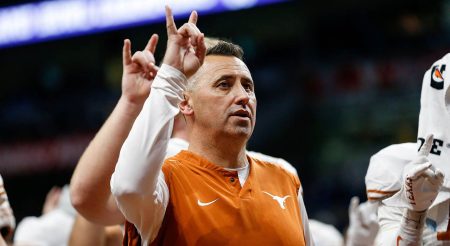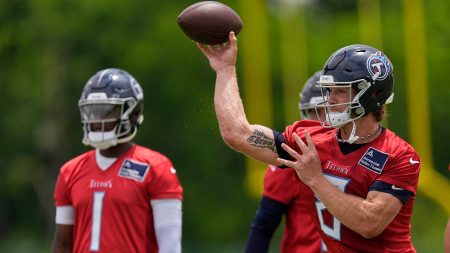The Minnesota Vikings, led by quarterback Sam Darnold, delivered a commanding performance at U.S. Bank Stadium, trouncing the Atlanta Falcons 42-21. This victory not only solidified the Vikings’ impressive 11-2 record but also highlighted the stark contrast in quarterback play between Darnold and his predecessor, Kirk Cousins, who returned to his former home turf as the Falcons’ starting quarterback. Darnold orchestrated a masterful offensive display, throwing for five touchdowns and accumulating over 300 yards, completing 22 of 28 passes for 347 yards. In contrast, Cousins, despite throwing for a comparable 344 yards, struggled with turnovers, throwing two interceptions and failing to find the end zone.
The game began with a promising drive for the Falcons, culminating in a Tyler Allgeier touchdown run. This early success hinted at a potential upset, especially considering Cousins’ recent struggles with ball security, which had drawn criticism even from the mother of Vikings running back Aaron Jones. However, the Falcons’ momentum was abruptly halted by a turnover on downs on their subsequent drive. This pivotal moment shifted the game’s trajectory, as the Vikings capitalized on the opportunity, with Darnold connecting with Jordan Addison for a 49-yard touchdown pass, tying the game after the extra point. This marked the beginning of a dominant performance by Addison, who would go on to score three of Darnold’s five touchdown passes.
The Vikings’ offense continued to fire on all cylinders. Darnold found star receiver Justin Jefferson for a 12-yard touchdown, Jefferson’s first score since Week 7, a surprising drought for the team’s leading receiver. Later, another broken play resulted in a 52-yard touchdown pass to Jefferson, showcasing Darnold’s ability to capitalize on opportunities and Jefferson’s game-breaking speed. Addison’s stellar performance continued as he led the game with 133 receiving yards on eight receptions. Jefferson was close behind with 132 yards on seven catches, demonstrating the Vikings’ potent receiving corps.
The Vikings’ dominance solidified in the fourth quarter, outscoring the Falcons 21-0, including a touchdown run by Aaron Jones, who contributed 73 rushing yards on 13 carries. While the Falcons managed a touchdown run by Bijan Robinson, who led the game with 92 rushing yards on 22 carries, it was insufficient to overcome the Vikings’ offensive onslaught. The Vikings’ balanced attack, featuring both a potent passing game and a productive rushing attack, proved too much for the Falcons to handle.
Cousins’ struggles were further compounded by his inability to connect with his receivers for touchdowns. While Darnell Mooney emerged as his top target with 142 yards on six receptions, and Ray-Ray McCloud contributed 98 yards on eight receptions, the lack of touchdowns underscored the Falcons’ offensive woes. The game served as a stark reminder of the Vikings’ successful transition at the quarterback position. Darnold’s efficient performance and ability to distribute the ball effectively to multiple receivers highlighted the Vikings’ newfound offensive firepower.
In contrast, Cousins’ return to Minnesota was marked by interceptions and a lack of scoring, further emphasizing the Falcons’ offensive struggles. While the Falcons showed flashes of potential early in the game, their inability to sustain drives and capitalize on opportunities ultimately led to their downfall. The Vikings’ victory underscored their status as a Super Bowl contender, showcasing their balanced offense, strong defense, and overall team cohesion. The Falcons, on the other hand, will need to address their offensive inconsistencies and Cousins’ turnover issues if they hope to improve upon their disappointing season. The game was a homecoming of sorts for Cousins, but it was Darnold who stole the show, solidifying his place as the Vikings’ new quarterback and leading his team to a convincing victory.










